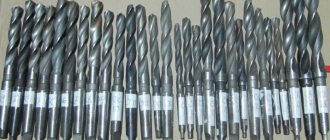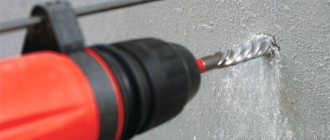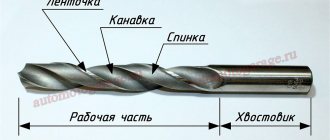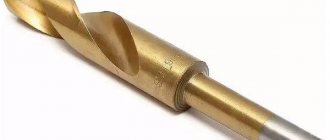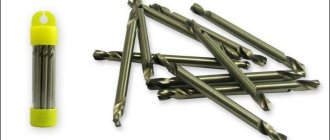The working part of a step drill for metal (also called a cone drill) is formed by a spiral groove and a number of stepped annular transitions of different diameters. Thanks to this unique design, step drills allow you to determine at any time during processing what diameter the hole has been formed.
One step drill can replace a set for metal processing, including crowns
At first glance, it may seem that using such drills (which, by the way, are quite expensive) does not make much sense, because you can always select a tool of a certain diameter and use it to create the required hole. Meanwhile, conical tools for drilling holes have a number of unique advantages that make their use justified in many cases.
Feather drill
This drill has a fairly simple and already outdated design and is used quite rarely in practice.
Feather drills come in two types: single-sided and double-sided. Single-sided ones can only be drilled when rotating in one direction, and double-sided ones - in both directions.
One of the main disadvantages of feather drills is that they cannot withstand significant mechanical loads. Therefore, they cannot be drilled at high cutting speeds; in addition, they are not suitable for drilling holes of significant diameters. Spade drills are designed in such a way that no chips are removed from the hole during the drilling process. Such drills often “lead” to the side; their cutting edges quickly become dull and wear out.
Classification of drills [edit | edit code ]
According to the design of the working part
there are:
- Spiral (screw)
drills are the most common drills, with a drill diameter from 0.1 to 80 mm and a working part length of up to 275 mm, widely used for drilling various materials.
- Zhirov’s designs
- on the cutting part there are three cones with angles at the apex: 2φ=116...118°; 2φ=70°; 2φ ' =55°. This increases the length of the cutting edge and improves heat dissipation conditions. A groove 0.15D wide and deep is cut into the jumper. The jumper is sharpened at an angle of 25° to the axis of the drill in a section of 1/3 of the length of the cutting edge. As a result, a positive angle γ≈5° is formed.
- Flat
(
feather
; jargon:
perki
) - used when drilling holes of large diameters and depths. The cutting part has the form of a plate (blade), which is mounted in a holder or boring bar or is integral with the shank. - Forstner drills
are an improved version of a feather drill, with additional cutters. - For deep drilling (L≥5D)
- elongated screw drills with two screw channels for internal coolant supply. Screw channels pass through the body of the drill or through tubes soldered into grooves milled into the back of the drill. - The designs of Yudovin and Masarnovsky
are distinguished by a large angle of inclination and the shape of the helical groove (ω=50...65°). There is no need to frequently remove the drill from the hole to remove chips, thereby increasing productivity. - Single-sided cutting
- used to make precise holes due to the presence of a guide (support) surface (the cutting edges are located on one side of the drill axis). - Cannon blades
are a rod whose front end is cut in half and forms a channel for removing chips. To guide the drill, a hole must first be drilled to a depth of 0.5...0.8D. - Gun
- used for drilling deep holes. They are made from a tube, which, when crimped, produces a straight groove for removing chips with an angle of 110...120° and a cavity for supplying coolant. - Hollow
(also annular, core) - drills that turn only a narrow annular part of the material into chips. - Centering
- used for drilling center holes in parts. - Stepped
- for drilling holes of different diameters in sheet materials with one drill. - with cylindrical shank (GOST 10902-77, DIN 338)
- with tapered shank (GOST 10903-77 (Morse taper), DIN 345)
- with three-, four- and hexagonal shank
- SDS, SDS+, etc.
By manufacturing method
there are:
- Solid
- spiral drills made of high-speed steel grades R9, R18, R9K15, R6M5, R6M5K5, or carbide. - Welded
- twist drills with a diameter of more than 20 mm are often made welded (the tail part is made of carbon and the working part is made of high-speed steel). - Equipped with carbide inserts
- available with straight, oblique and helical grooves (including ω=60° for deep drilling). - With replaceable carbide inserts
- also called cased (the mandrel to which the inserts are attached is called the body). Mainly used for drilling holes of 12 mm or more. - With replaceable carbide heads
- an alternative to case drills.
Read also: DIY plywood knife handle
By purpose [edit | edit code ]
According to the shape of the holes being machined
there are:
According to the processed material
there are:
- Universal
- For processing metals and alloys
- For processing concrete, brick, stone
- it has a carbide tip designed for drilling hard materials (brick, concrete) with rotary impact drilling. Drills designed for a conventional drill have a cylindrical shank. The drill shank for rotary hammers has different configurations: cylindrical shank, SDS-plus, SDS-top, SDS-max, etc. - For processing glass, ceramics
- For wood processing
Straight Flute Drills
Drills of this type are mainly used when it is necessary to drill holes in thin sheets. They are best suited for this purpose when soft and tough metals and their alloys (for example, brass, copper, etc.) are to be processed. The main distinguishing feature of this tool is that when drilling, it does not jam or screw in, as is often the case with other types of drills (in particular, with twist drills). It should also be noted that the process of manufacturing drills with straight flutes is quite simple, and largely for this reason they are much cheaper than twist ones. Their cutting parts are often plates made of hard alloys, which significantly improves the performance characteristics of the tool.
What to look for when choosing a conical drill
You should make a choice of a tool such as a conical drill for metal only after you have become familiar with its characteristics. The color of a step drill can tell you a lot about it.
- The gray-steel color of the manufacturing material indicates that the drill has not been subjected to any heat treatment; therefore, you should not count on its high quality.
- The conical tool, the surface of which is black, has been treated with hot steam, which increases its strength.
- The golden color of the steel indicates that all internal stresses in the metal were previously eliminated, which improved its quality characteristics.
- If the surface of a step drill has a bright golden hue, it is highly wear-resistant. This is provided by the titanium nitride contained in the metal. The fairly high cost of such products is fully compensated by their long service life.
The marking of a step drill indicates its characteristics
For the production of cone drills, various types of steel are used, which are determined by marking. If the marking contains the abbreviation HSS, this means that with this product you can perform high-speed processing without worrying about it deforming or losing its strength characteristics under intense heating.
When choosing a step drill, pay attention to the main dimensions
When choosing cone drills, you must also consider the following parameters:
- diameter, which completely depends on the characteristics of the holes that need to be obtained;
- brand (this parameter largely determines not only the quality of the product, but also its cost);
- compliance of the purchased conical drill and the material from which it is made with all GOST requirements;
- possibility of multiple sharpening (here you should be guided only by your own preferences and experience in sharpening spiral and conical drills in accordance with GOST requirements).
Twist drills
Twist drills are now the most used and are distinguished by their versatility. One of their main characteristics is efficient chip removal. Drills of this type have in their design two grooves arranged in a spiral. It is through them that chips and coolant are discharged; they also form the cutting edges.
Most often, twist drills are manufactured in such a way that they have a right-hand helical flute. On special machines, drills with a left-hand helical flute are often used.
Experts divide all twist drills into two main types: with a cylindrical shank (cylindrical) and a conical shank (conical). For the manufacture of twist drills, steel grades P18, P9 and 9ХС are used.
Often twist drills are equipped with carbide inserts. This tool is intended for drilling and reaming holes in hardened steel, cast iron, marble, and glass. A characteristic feature of spiral sears with carbide inserts is a shortened working part, a smaller angle of inclination of the helical groove, and a larger core diameter. These drills have high wear resistance.
In cases where large holes are drilled, drills with internal cooling are often used. In their design there are special holes that run along a helical line and through which coolant is supplied to the cutting edges.
Scope and design features
Cone (or step) drills have a long working life, which is ensured by the high strength of their cutting edges. Unlike a conventional drill, a cone drill allows you to perform technological operations that in any other situation would require the use of several tools. It is this versatility that largely explains the high cost of drills in this category.
The conical drilling tool, due to its design features, allows processing at high speed, at which the quality of the edge of holes formed even in thin sheet material is not reduced.
Step drill device
Cone drills can make holes not only in metal, but also in drywall, wood, plastic, etc. They also successfully cope with dense metal, which cannot be said about any other type of drilling tool.
The sharp tip of the step drill not only eliminates the need for a centering tool, but also easily cuts into the structure of even the densest metal. The resulting hole does not require additional processing using a needle file and a grinder.
Most step drills are capable of drilling through metal up to 4mm thick
The progressive channels of the step drill, arranged in a spiral, are made in different sizes with a smooth transition. This design feature increases the efficiency of the cone drill when working with thin sheet metal by at least 50%. In addition, when drilling metal parts with a tool with such spiral translational grooves, its smoothness is ensured.
Cone-type drills can be used either in conjunction with a manual drilling device or when installed on special equipment.
An abrasive coating based on diamond or titanium chips can be applied to the working surface of step drills (this does not contradict the requirements of GOST). This coating of the cutting surface significantly increases its strength, which makes it possible to minimize the frequency of sharpening. Naturally, you can count on this advantage of using a sprayed cone drill if the rules for its operation are followed and the permissible load on it is not exceeded.
These drill bits are made from high quality high speed steel with titanium coating.
One of the tasks that can be solved with the help of a cone drill is the correction of defects in holes produced by a tool of another type. Such defects, in particular, include torn edges. Step-type drills are practically irreplaceable in cases where it is necessary to obtain high-quality holes in thin sheet metal, products made of fiberglass and other polymer materials.
Considering all of the above, we can conclude that cone drills are even more versatile than traditional twist-type tools. That is why they will not be superfluous at the production site and in the home workshop. How convenient and effective a cone tool is, the cost of which depends both on the diameter of the working part and on the type of spraying, can be judged by the video of processing with its use and by reviews from specialists.
